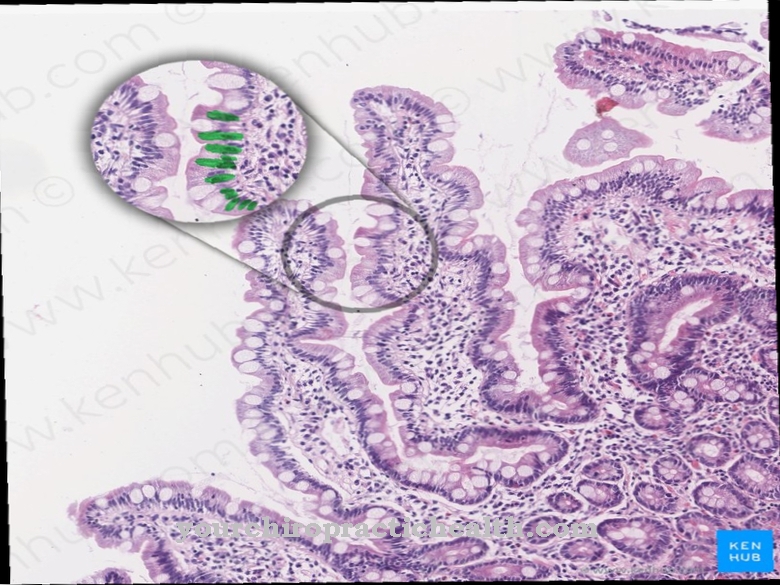Fascine represent small and extremely compact protein molecules that interact with the actin filaments. In doing so, they bundle the actin chains and thus prevent their further networking. Fascins also serve as markers in cancer diagnosis.
What is Fascin?
Fascins are proteins that regulate the activity of actin filaments. Their task is to package the actin filaments in such a way that they are connected to one another in a parallel and rigid manner at the binding points. The binding to the actin chains takes place through phosphorylation.
To do this, they have two binding sites and form bundles of actin filaments with a distance of ten nanometers each. The fascins themselves are very small and compact molecules. Their weight is approximately 55 to 58 kilodaltons. They play a major role in the movement of actin filaments and thus also of the cells. There is a lot of fascin mainly in the actin-rich cell protrusions. These cell protrusions are also known as filopodia. Filopodia are known as the so-called pseudopods of radiant animals, which can also move with their help.
But all eukaryotic cells also have these protuberances, so that they can both interact with other cells and serve to help them move. There are generally three different forms of fascins, which are also coded by different genes. The so-called Fascin 1 (FSCN 1) occurs mainly in the neurons. But other cells also contain it in different concentrations. Fascin 2 (FSCH 2) is formed in the retina of the eyes and Fascin 3 (FSCN 3) is only present in the testes.
Function, effect & tasks
The most important function of Fascin is to stabilize the actin fibers by bundling them. The actin filaments cross-link less and thus contribute to the movement of the cell organelles within the cell and the cell itself. Fascin is expressed in all body cells. However, it is different for the individual cell types.
There are cells that are more mobile than others. Immune cells often have to get to their destination quickly when a focus of infection develops in a certain region of the body. The activity of actin fibers can be illustrated well using the example of macrophages. When the macrophages (phagocytes) reach the infectious invaders, they trap them.
In doing so, they form filopodia, which enclose the corresponding bacteria or foreign proteins. So they can incorporate them and dissolve them within the cell. The more mobile the cell has to be, the higher the concentrations of fascinates. The less fascin there is, the more interconnected the actin filaments are. This leads to more stationary cells.
Education, occurrence, properties & optimal values
The fascins are accompanying proteins of the actin filaments. As already mentioned above, they ensure that the actin chains are bundled and thereby pack them. This creates bundles of parallel actin filaments which, due to the packaging, lose the ability to network further. Actin consists of chains of protein molecules, which make up the bulk of the cytoskeleton. With the help of the cytoskeleton, the cells can move. Without bundling the actin filaments, they would network with one another and restrict cell movement.
An actin filament consists of a double helix of two actin chains. The Fascin encloses a bundle of actin filaments and ties them to two contact points. These contact points are formed by phosphorylation. In phosphorylation, a phosphate group from ATP binds to a hydroxyl group of an amino acid. In the case of the fascine, this is serine. The phosphates thus link the fascin molecule with the actin molecule. With the restriction of cross-linking, however, the active mobility of the actin filaments (motility) along the chain is promoted. This is brought about by the constant breakdown of the actin chain on the one hand with the simultaneous addition of amino acids on the other.
This process also only takes place with the help of phosphorylation with the participation of ATP and ADP. These processes create an active movement of the actin fibers. First of all, the cell protrusions (filopodia) are created, which then ensure the active movement of the cells. By stabilizing the actin filaments with fascin and inhibiting their crosslinking, the motility of the actin fibers is promoted
Diseases & Disorders
It was also found that the concentration of fascin is increased in many malignant tumor cells. The resulting increased motility of these cells increases the risk of metastasis. The corresponding cells penetrate other tissues more easily and form new tumors (metastases) there. How the process actually works is still the subject of research.
It is known, however, that the filopodia play a major role in these cancer cells and that the actin fibers are stabilized there by fascin. Fascin can be used as a tumor marker for diagnosing malignant neoplasms. However, an increased concentration of fascin does not automatically mean that a diagnosis of cancer can be made. This finding is only an indication of a possible metastatic tumor. Because increased fascin values are not specific for tumors.The concentration of fascins can also be increased in other diseases.
This is especially true for diseases in which there is an increased formation of immune cells. The immune cells have to be very mobile in order to be quickly present in any part of the organism. A good example of this is infection with the Epstein-Barr virus. B-lymphocytes, which contain a particularly large amount of fascin, are increasingly formed here.






.jpg)




















